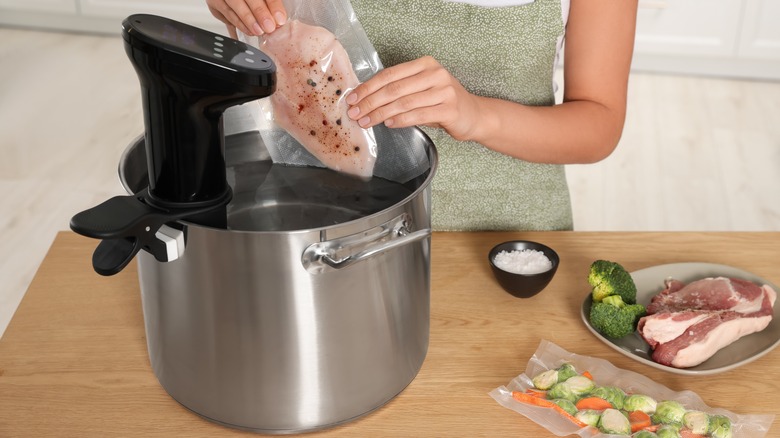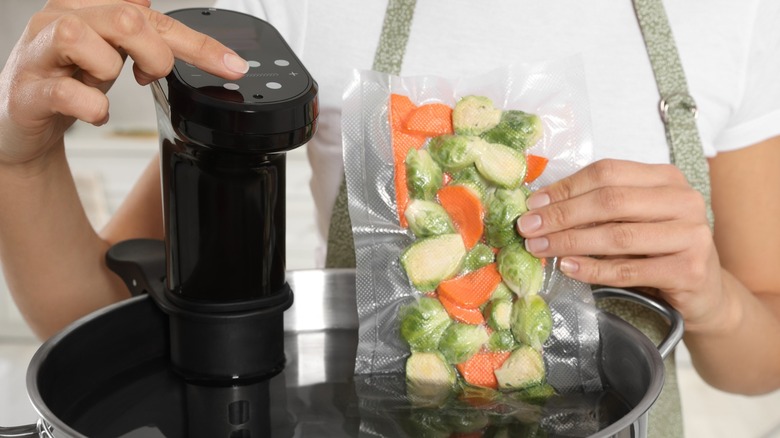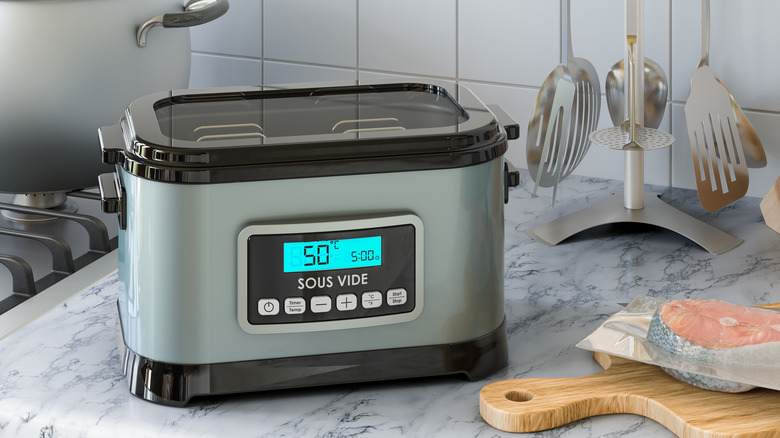Reheat Your Leftovers Sous Vide And Thank Us Later
Reheating leftovers in the microwave can lead to mushy and uninspiring results. Don't settle for diminishing returns — switch to sous vide, a fool-proof way to revive former meals without risking lukewarm results. The sous vide process is simple — seal your leftovers in a bag, drop them into a water bath, and set an immersion circulator to 165 degrees Fahrenheit (per the USDA). This results in tender, flavorful, and anything-but-dry leftovers that are just as delicious (if not better) than their first go-around.
Sous vide reheating takes about 30 minutes for fridge leftovers (and 30 additional minutes for frozen leftovers), just enough time to prep additional sides and set the dinner table. And thanks to a fixed temperature setting and moist environment, it's nearly impossible for your food to overcook if you leave contents longer than intended. Leftovers should be submerged in freezer bags, vacuum-sealed bags, or mason jars, so you'll want these on hand.
You'll also need a sous vide device to get started. Two popular options include Breville's Joule sous vide circulator while some models of the Instant Pot also have a sous vide setting. Both devices are easy to use and allow you to set the exact temperature and time setting for optimal control — no complex culinary formulas needed.
The benefits of reheating leftovers with sous vide
The primary perk of sous vide is its ability to keep foods moist and flavorful. The airtight cooking environment infuses food into its juices and seasonings. Say you warm up a stew in the microwave — the top layer is tough and dry, while the center is disappointingly cold because microwaves heat the outer food layers more quickly than the center. In contrast, the sous vide method slowly and evenly reheats your entire dish without losing a drop of moisture, as there's no way for it to escape from the bag.
If planning balanced meals full of nutrients is your priority, sous vide is also the best route. Because the plastic bag insulates the ingredients, there's a generally higher retention of heat-sensitive vitamins and minerals that would otherwise disperse in water or be lost to the high heat of a microwave. The set temperature of the sous vide also keeps the food's molecular structure intact, which means a more delectable texture.
Is your fridge crammed with extras, just waiting to spill over? Sous vide packaging can save the day. Unlike bulky Tupperware containers, vacuum-packed bags and freezer bags take up less volume overall. This frees up valuable real estate and additional storage, a meal prepper's dream come true. Vacuum-sealed bags also keep leftovers fresher for longer and, when properly frozen, can be stored for two to three years.
The foods that reheat best with the sous vide method
Most leftover dishes can be revived with a sous vide circulator, but some choices are better than others. Food scientists discovered that placing tough cuts of meat in a sous vide bath would tenderize the proteins without shrinking or drying them out. This means beef briskets, lamb shanks, and pork shoulders are flagship cuts for this low-and-slow cooking process. Sous vide is also one of the best ways to reheat leftover steak, chicken, and even eggs.
But one isn't limited to protein-based leftovers. Firm vegetables like carrots, asparagus, and potatoes can hold their form and do well in a water bath without getting too mushy. Leftovers with multiple ingredients, like stews, sauces, soups, and stir-fries, are all fair game. You can reheat carne asada strips for taco night, marinara sauce to accompany spaghetti, or a big batch of beef chili, all perfect for sous vide because they maintain their liquid content and flavor.
No reheating method is perfect, and a few items don't mix well within a sous vide bath. Fried food is particularly challenging since sous vide will leave the formerly crispy skin soggy. Similarly, bread-based dishes such as cakes and dinner rolls may lose form and texture. Cream-based sauces and cheeses are also susceptible to separation and graininess when cooked using this method. As a rule of thumb, sous vide moist foods and opt for an air fryer or toaster oven when reheating crispy items with delicate textures.



